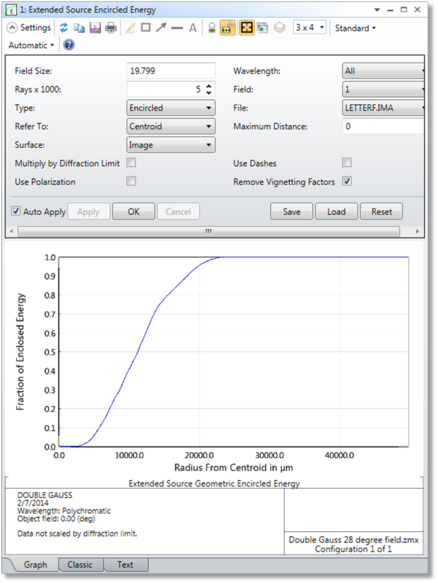Extended Source
Computes encircled energy using an extended source similar to the geometric image analysis feature.

Field Size This value defines the full width of the square image file in field coordinates, which may be either lens units or degrees, depending upon the current field definition (heights or angles, respectively).
Rays x 1000 This setting determines approximately how many rays will be traced. The number of rays traced is approximately 1000 times the specified value. The reason the number of rays is only approximate is because the distribution of rays over the pixels in the image must be uniform. For example, if there are 1500 pixels in an image file, then at least 1500 rays will be traced, even if a value of 1 is selected. The distribution of rays at each wavelength is in proportion to the wavelength weights.
Type The analysis type option specifies how the encircled energy is calculated; either encircled (radial), X-only, Y-only, or ensquared. The X-only and Y-only options are sometimes called "enslitted" and correspond to the total fraction of energy contained within an expanding slit.
There are also options for X- or Y-distributions, which show the energy distribution in either x or y directions. These latter two options also report the geometric full width at half max. The X- or Y- distributions are the amount of energy falling on a pixel which is narrow in one direction and infinite in the other direction.
Refer To Select either chief ray, centroid, or surface vertex as the reference point.
Surface Selects the surface at which the data is to be evaluated. This is useful for evaluating intermediate images. See "Evaluating results at intermediate surfaces".
Use Polarization If checked, polarization is considered. See " Polarization (system explorer) " for information on defining the polarization state and how polarization is used by analysis features.
Multiplyby Diffraction Limit If checked, OpticStudio approximates the diffraction encircled energy by scaling the geometric data by the theoretical diffraction limit curve. The diffraction limit curve OpticStudio uses is based upon the unobscured circular pupil. The only way to compute the obscured pupil diffraction limit function would be to perform the exact diffraction calculation, in which case the diffraction encircled energy feature should be used instead. The diffraction limit approximation is only useful for systems with unobscured pupils and modest field angles, since the approximation ignores the change in F/# with field. This option is only available for Type = encircled.
Wavelength The wavelength number to be used in the calculation.
Field The image file may be centered on any defined field position. This permits a small target such as a bar chart to be moved to any location in the field of view.
File The name of the .IMA image file. This file must reside in the <images> folder (see " Folders "). See the discussion section in the Geometric Image Analysis feature for a full description of the IMA file format.
Max Distance This setting overrides the default scaling. The units are micrometers. To choose the default scaling option, enter zero.
Use Dashes Selects either solid lines or dashed lines to differentiate the various curves. This setting only applies to the Classic view, which is an option if "Enable Classic View" is selected in the Graphics tab of the OpticStudio Preferences.
Remove Vignetting Factors If checked, vignetting factors are automatically removed. See "Comment about vignetting factors".
Discussion The X- and Y-only options will compute the fraction of rays which are contained with plus or minus the specified distance from either the chief ray or the image centroid. If a scale of 10 micrometers is shown, then the region enclosed is 20 micrometers across (and infinite in the other direction). The geometric encircled energy is not a good indicator of performance if the system is close to diffraction limited.
See the Geometric Image Analysis feature discussion for details about extended source modeling and the IMA file format.
Next:


